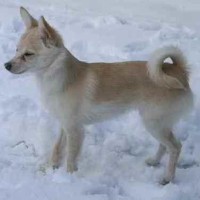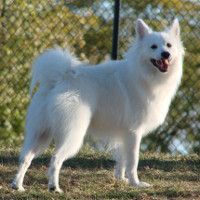Appearance of the Chimo
|
| The Chimo may lean towards either of the parent breeds in appearance, but it is generally a small, even toy-sized brand dog, no bigger than 25.5 centimeters and weighing around 4.5 kilos. However, Chimo can be larger and weigh more if the parent breed is a standard American Eskimo Dog. The head is round with a fine, long muzzle in proportion to the head. The eyes can vary in color from light to dark brown and are round to slightly oval, expressive and cheerful. The coat can vary in color but is generally light, with white or cream in variations of two or three colors. A Chimo's hair is always soft and fluffy, but may lie flatter against the body in the hybrid than in the parent American Eskimo Dog. |
Temperament of the Chimo
|
| The Chimo is a friendly, intelligent hybrid that's eager to please, thanks to the American Eskimo Dog parent. Any stubbornness you find in your Chimo is sure to come from the Chihuahua parent, but the Chimo is considered an outgoing, loving and trainable hybrid. As far as children are concerned, the Chimo is a remarkably patient and loving companion, but may not be suitable for small children. The American Eskimo Dog parent makes the Chimo more resilient, and teaching children how to interact with dogs will help with good socialization. The Chimo gets along very well with other dogs and cats with good socialization, but the Chihuahua parent can interfere with true harmonization if not well socialized. Chimo can be slightly wary of strangers, but early socialization will help them develop friendliness towards unfamiliar, non-threatening people. Energy levels in the Chimo are high with moderate intensity, but they are small enough to get daily exercise indoors, which will keep their minds sharp and their bodies healthy. |
Needs and activities of the Chimo
|
| The Chimo is a hybrid of two high-energy breeds. The Chihuahua needs less intense activity, while the American Eskimo Dog can be high-energy and require slightly more daily activity. Your Chimo will love to run and jump, and will require between 1 and 2 hours of regular exercise. However, the small size of this mix means that the Chimo can get some of its exercise needs indoors. The Chimo is remarkably well adapted to apartment and city living, and both parent breeds strike a perfect balance in climate tolerance. The Chimo is capable of living in both hot and cold climates, and is ideally suited to temperate environments. However, during the warmer months, watch out for any signs of overheating, as your Chimo inherits the coat of its American Eskimo Dog parent. |
Maintenance of the Chimo
|
| Descended from two non-hypoallergenic breeds, the Chimo is not hypoallergenic and is considered a medium to high excretor. The Chimo's long, soft hair should be brushed daily to prevent matting and tangling, and to keep the coat looking its best. Frequent brushing will also help evenly distribute the natural oils that keep the skin and coat healthy. These dogs aren't known for developing a doggy odor, but regular brushing will help keep the coat clean and prevent odors from developing. While brushing your Chimo's coat, also check the ears and remove any build-up of wax, dirt or debris with a vet-approved cleaning solution. |









 English (United Kingdom)
English (United Kingdom)